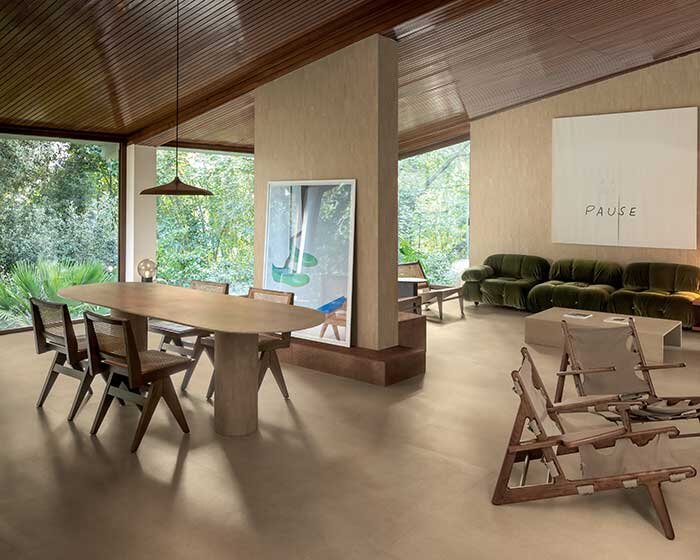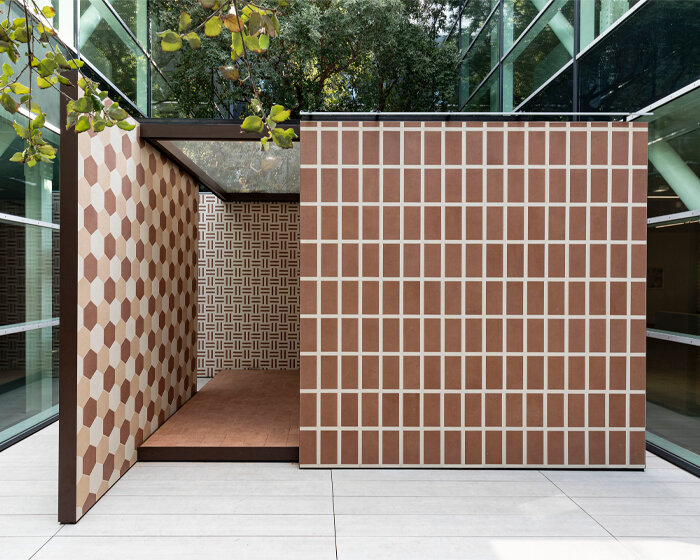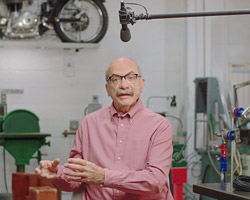interview with IDEO industrial designer ricardo figueiroa on the future of automobility
all images courtesy of IDEO
‘the future of automobility‘ is a conceptual vision from the global design and innovation firm by IDEO, responding to the future of autonomous driving, on demand delivery services, and the future of the workspace. ‘as business models, technical innovations and user needs evolve, we expect to continue to see many exciting developments in the transportation and mobility domain,’ explains ricardo figueiroa, an industrial designer and portfolio director at the company. ‘this particular automobility point of view presents three scenarios influenced by patterns that IDEO has observed across all of its transportation design work in recent years. each illustrates the power of semi-autonomous and autonomous vehicles and the role they will play in our lives over time from systemic, technology, and human-centered perspectives.’

21st century mule ‘CODY’ concept — delivering everything from your jeans to a hot lunch, almost instantly
‘at IDEO, we are thinking about the broader range of impact that automobility will have on our lives and on the infrastructure in which we live,’ he adds. ‘based on our design thinking approach, we take into account business, technology and disability lenses as we spot patterns that indicate how things may play out in the future. for consumers, they may be presented a choice of owning a vehicle or owning access to one. they also may have greater choices of where to live. commutes may be ‘invertible’ with work coming to them instead of traveling to a workplace. for businesses, timely delivery of goods will further enhance their productivity. we expect that businesses will have more flexibility in how they expand and that automobility will play a role in where they find themselves.’
designboom speaks with ricardo figueiroa who talks about his previous design experiences before IDEO, and offers his personal insights on the ‘future of automobility’.
animation of how the 21st-century mule would work
video courtesy of IDEO

service window of the mule
designboom (DB) could you tell us briefly about your background and the evolution of your work?
ricardo figueiroa (RF): I studied industrial design at ESAD in porto – where I was born and raised – and completed my masters in product design at the engineering school in barcelona. after a brief stint as a car designer at SEAT in barcelona, I was offered the wonderful opportunity to join IDEO in the bay area, where I’ve been practicing design for the last eight years. my role has evolved over the years and for the past four years I’ve focused on leading creative and multidisciplinary teams on a variety of projects, ranging from traditional industrial design work to helping companies become more innovative.

‘CODY’ would be monitored and activated through an accompanying app
DB: how did you originally get introduced to the world of design?
RF: I guess it all began when i was six years old and got labeled as an ‘artist’ by my teacher. for four years, I attended catholic school and our weekly religious assignments usually consisted of making drawings that represented abstract concepts like happiness, hope, love, freedom. apparently, I was reasonably good at it and the artist label fueled my confidence. then, when I was 15, my mom went back to school for a second degree in architecture. for the following six years, I got exposed to late night mock-ups of buildings, dinner table conversations about le corbusier and got to play with some of the earlier versions of autoCAD.
automobility commuter concept
video courtesy of IDEO

the commuter concept responds to the inefficient relationship between cars and infrastructure
DB: you’ve previously worked in the furniture and automotive design industries – how does your past experience influence the decisions you make as a designer at IDEO?
RF: I think it gave me the humility to understand that each industry has its own idiosyncrasies and that specific aesthetics and ways of working don’t necessarily translate easily. one should challenge convention, but before doing so, it’s important to study the good and bad and figure out where to focus on innovating. for example, often times when car designers get to design laptops and smartphones, they end up looking like cars even though aerodynamics play no part in either of those products. I try to keep a catalog of tricks of the trade of different industries and remain sensitive to the right contexts in which to apply them.
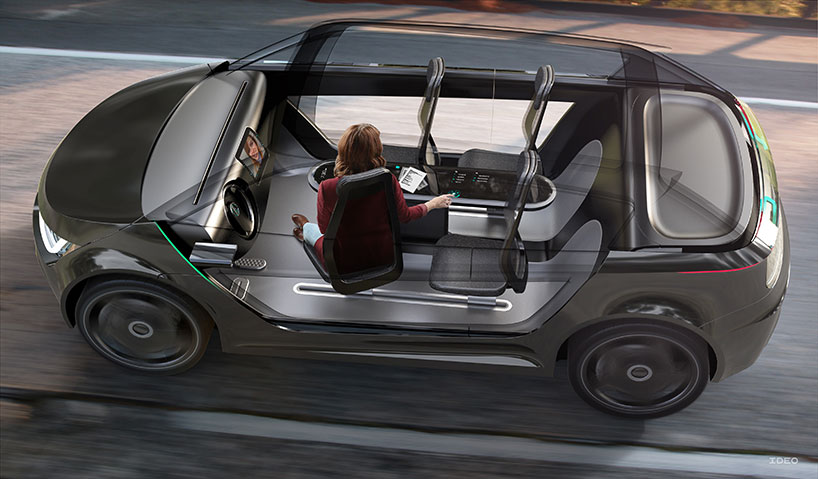
commuter concept envisions a world where slow becomes fast
DB: can you talk about the future of automobility?
this was a fun project. danny stillion, who is leading efforts around transportation and mobility design at IDEO, approached me to help turn IDEO’s resident knowledge in this space into three distinct and provocative concepts with enough visual fidelity to make people stop and look.
we set out to visualize a range of possible future mobility concepts tied to various levels of automation. the first chapter illustrates how we might make the most of time spent while commuting. this is accomplished by providing drivers with the ability to link to or ‘platoon’ with other cars traveling to similar destinations. once linked, drivers can gracefully hand over the driving to automated systems for common commuting routes.
the second chapter focuses on what might come about if we apply autonomous vehicle technology to the package delivery space. we see such platforms co-existing with today’s routes driven by people, for example, allowing intense delivery routes to be part automated to allow extra assistance and a higher level of service to people who need it most such as the elderly. finally, the concept visualized in the third chapter, shows what an inverse commute might feel like. this concept takes advantage of autonomous vehicle technology to provide flexible working spaces on demand reducing peak commuting loads and putting spaces such as parking lots to use in cities that have critical space needs.

envisioning the alternative uses of the commuter vehicle
each concept sits on a timeline that goes from near term to a future some years out and takes into account shifts that we see happening around human behavior, technology and business. my personal goal was to create provocations that contribute to the conversations and the collective mental images that we have on the future of automobility and the impact it might have in our cities. for example, how might it feel to be able to talk to a delivery vehicle as if it were a person? what if delivery vehicles or work spaces on demand become part of the identity of a city? how will behavior change if you can use commute time to be productive?

detail of the ‘commuter’ concept’s dashboard interface
‘nexus’ – inverse commute
video courtesy of IDEO
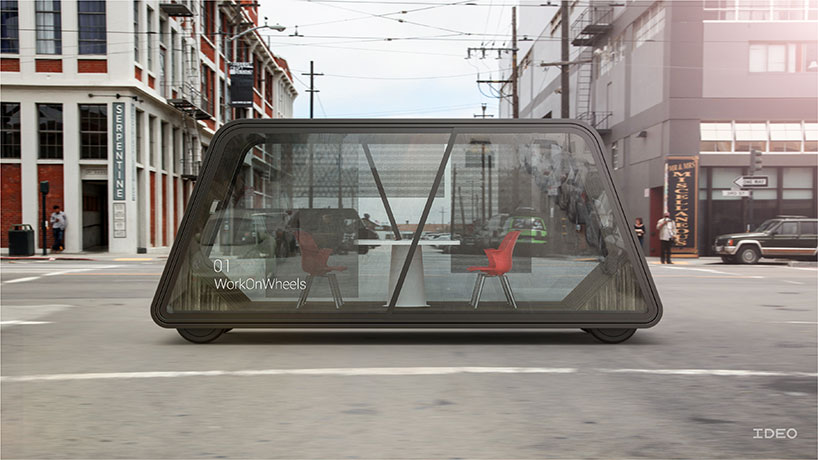
‘nexus’ explores how working spaces can come closer to where people live instead of commuters heading to pre-determined workplaces
DB: what has been the most rewarding project that you’ve ever been a part of?
RF: when I first joined IDEO, I worked on the design of a new conference chair for a full year, full time. most importantly, I got to spend plenty of time working side by side with thomas overthun, who’s been a mentor of mine. even though the final product never progressed to market, I still reap the benefits of that experience today because it was a foundational experience for me. I try to use it as a reference point when I find myself mentoring younger designers.

possible workplace scenario using the ‘nexus’ vehicle
DB: what are your thoughts on the self-driving car and the idea of an autonomous future?
RF: I hope the paradigm shift that we’re witnessing can deliver on the promise of more safety and efficiency. I think we’ll see an increasing focus on solutions that provide efficient mobility of people and goods with less emphasis on personal ownership and tighter integration of different forms of transportation.

the future of automobility and the workplace
DB: do you have a design philosophy?
RF: I’m a big fan of paul rand’s writings and I love his quote on the overriding motivations that drive designers: ‘art in the service of business, art that enhances the quality of life and deepens appreciation of the familiar world.’ at IDEO, I always think of my work and the work of the teams that I lead as trying to please three audiences: the end user, because if you failed them nothing else matters; the client, because design is also about solving business problems; and your peers, because if they get excited it means you’re pushing the discipline forward. if you do all of the above, you end up pleasing a fourth one: yourself. and that’s what gives you the motivation to take on the next project with the same passion as your very first one.

‘nexus’ would be equipped with digitally interactive furniture to enhance working needs
DB: do you have any pieces of advice?
RF: there’s an expression that stuck with me for a few years now: ‘strong beliefs, loosely held’. if you do something, mean it. but always be willing to be shown a different, better way.

ricardo figueiroa, industrial designer and portfolio director at IDEO
for more on the future of automobility, check out the interactive website here.
happening now! with sensiterre, florim and matteo thun explore the architectural potential of one of the oldest materials—clay—through a refined and tactile language.

